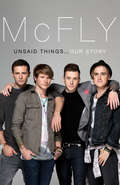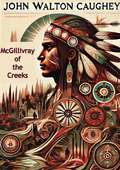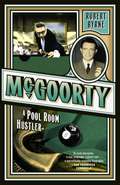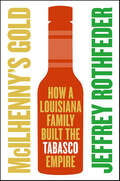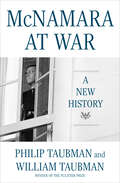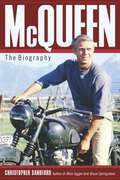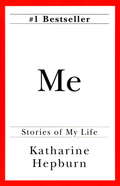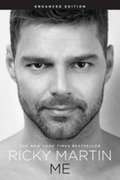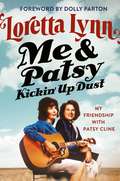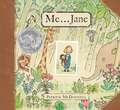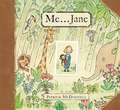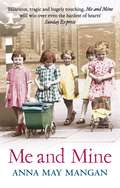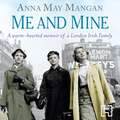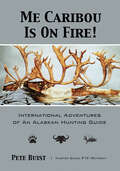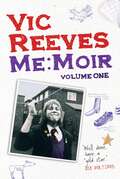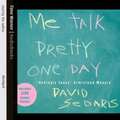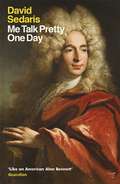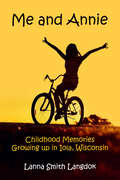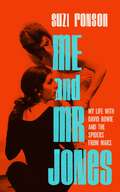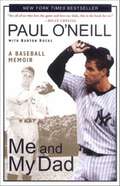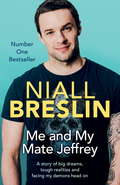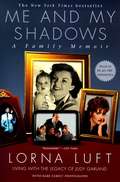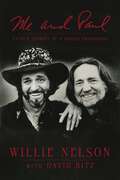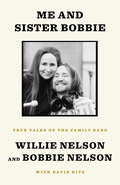- Table View
- List View
McFly - Unsaid Things...Our Story
by Tom Fletcher Danny Jones Harry Judd Dougie PoynterThe intimate - and surprising - autobiography of Britain's most adored bandPrepare to meet the real McFly …In 2003, Tom Fletcher, Danny Jones, Harry Judd and Dougie Poynter came together and formed what would become one of the most popular and successful bands in the UK. Just teenagers at the time, they were catapulted into the limelight and had to adapt quickly to their new-found fame – and everything that came with it. Now, at last, they have decided to tell their story, in full and revealing detail.Speaking with candour and their trademark humour, Tom, Danny, Harry and Dougie share both the stories of their own lives and that of McFly. They give their personal insights into their contrasting childhoods, the individual paths that led them to the band, the struggles they have each overcome, their love lives and, of course, their music.Packed with previously untold stories, a lot of laughter and the occasional tear, Unsaid Things offers a privileged look into the lives of four guys who started out as bandmates and became best friends. Their unique camaraderie radiates from every page and by the end of the book, you’ll know them almost as well as they know each other … Tom Fletcher, Danny Jones, Harry Judd and Dougie Poynter have been together as McFly since 2003. They hold the record for being the youngest band to have a debut No 1 album in the UK. Their hits include: 'Five Colours in Her Hair', 'All About You', 'Please, Please' and 'Shine a Light'. They are one of the biggest bands in the UK.
McGillivray of the Creeks
by John Walton Caughey"McGillivray of the Creeks" by John Walton Caughey is a meticulously researched biography that brings to life the extraordinary story of Alexander McGillivray, a key figure in the history of the Creek Nation and early American frontier diplomacy. Caughey, a distinguished historian, presents a comprehensive and engaging portrait of McGillivray, whose leadership and diplomacy significantly influenced the interactions between Native American tribes and the emerging United States.Alexander McGillivray, born to a Scottish trader and a Creek mother, navigated the complex cultural and political landscapes of his time with remarkable skill. Caughey delves into McGillivray's unique heritage and upbringing, illustrating how his bicultural background enabled him to become a powerful intermediary between the Creek Nation and European-American settlers. Through detailed narrative and analysis, Caughey explores McGillivray's rise to power as the principal chief of the Creeks and his efforts to protect his people's land and sovereignty amidst the encroaching pressures of colonial expansion.The book provides a vivid account of McGillivray's diplomatic endeavors, including his strategic alliances with Spanish, British, and American officials. Caughey highlights McGillivray's role in negotiating the Treaty of New York in 1790, which marked a significant moment in U.S.-Native American relations. Despite the treaty's mixed outcomes, McGillivray's ability to secure concessions from a fledgling United States government showcased his adeptness as a leader and negotiator."McGillivray of the Creeks" is more than just a biography; it is a rich historical narrative that offers insights into the broader geopolitical dynamics of the 18th-century American frontier. Caughey's rigorous scholarship and engaging prose make this book an essential resource for historians, students, and anyone interested in the complex history of Native American-European relations.John Walton Caughey's work stands as a significant contribution to our understanding of a pivotal era in American history, illuminating the legacy of Alexander McGillivray and his enduring impact on the Creek Nation and beyond.
McGoorty
by Robert ByrneThe Broadway Books Library of Larceny Luc Sante, General Editor McGoortyis master billiards writer Robert Byrne's racy account of the life of Danny McGoorty, a billiards champion of that bygone era when cue artists were often scam artists and pool rooms were held to be dens of iniquity. Hustler and hobo, womanizer and fashion plate, McGoorty was at once eyewitness to Capone's Chicago and the feats of greats like Willie Hoppe and Willie Mosconi. In an all-American voice at once sarcastic, profane, humorous, and chock full of colorful lingo, he relates his colorful and seedy life and times with a unique style and brio.
McIlhenny's Gold: How a Louisiana Family Built the Tabasco Empire
by Jeffrey RothfederIn this fascinating history, Jeffrey Rothfeder tells how, from a simple idea—the outgrowth of a handful of peppers planted on an isolated island on the Gulf of Mexico—a secretive family business emerged that would produce one of the best-known products in the world. A delectable and satisfying read for both Tabasco fans and business buffs, McIlhenny's Gold is the untold story of the continuing success of an eccentric, private company; a lively history of one of the most popular consumer products of all times; and an exploration of our desire to test the limits of human tolerance for fiery foods.
McNamara at War: A New History
by Philip Taubman William TaubmanA revelatory portrait of Robert S. McNamara, informed by newly discovered diaries, letters, and interviews with those closest to him. Robert S. McNamara was widely considered to be one of the most brilliant men of his generation. He was an invaluable ally of Presidents John F. Kennedy and Lyndon B. Johnson as U.S. secretary of defense, and he had a deeply moving relationship with Jackie Kennedy. But to the country, McNamara was the leading advocate for American escalation in Vietnam. He strongly advised Johnson to deploy hundreds of thousands of American ground troops, just weeks before concluding that the war was unwinnable, and for the next two and a half years, McNamara failed to urge Johnson to cut his losses and withdraw. McNamara at War examines McNamara’s life of intense personal contradictions, following his childhood, his career as a young faculty member at Harvard Business School, and his World War II service, to his leadership of the Ford Motor Company and the World Bank. Philip and William Taubman had access to materials previously unavailable to McNamara biographers, including Jacqueline Kennedy’s warm letters to McNamara during the Kennedy and Johnson administrations and beyond; family correspondence dating back to McNamara’s service in World War II; and a secret diary maintained by McNamara’s top Vietnam policy aide. What emerges is the comprehensive story of the infamous former leader of the Pentagon: riven by melancholy, guilt, zealous loyalty, and a profound inability to admit his flawed thinking about Vietnam before it was too late. McNamara at War is a portrait of a man at war with himself—with a grave influence on the history of the United States and the world.
McQueen: The Biography
by Christopher SandfordThe biography of the original Mr. Cool, Steve McQueen. The actor who perhaps, first epitomised the Action Hero; a complex man, prone to casual affairs and violence, yet capable of helping those more unfortunate than him.
Me
by Katharine HepburnAdmired and beloved by movie audiences for over sixty years, four-time Academy Award-winner Katharine Hepburn is an American classic. Now Miss Hepburn breaks her long-kept silence about her private life in this absorbing and provocative memoir.A NEW YORK TIMES Notable Book of the YearA Book-of-the-Month-Club Main SelectionNOTE: This edition does not include photographs.
Me
by Ricky MartinInternational superstar, Ricky Martin, who has sold more than 60 million albums worldwide, opens up for the first time about memories of his early childhood, experiences in the famed boy band Menudo, struggles with his identity during the Livin' la Vida Loca phenomenon, reflections on coming to terms with his sexuality, relationships that allowed him to embrace love, and life-changing decisions like devoting himself to helping children around the world and becoming a father. Me is an intimate memoir about the very liberating and spiritual journey of one of the most iconic pop-stars of our time.From the Hardcover edition.
Me & Patsy Kickin' Up Dust: My Friendship with Patsy Cline
by Loretta Lynn Patsy Lynn RussellMe & Patsy Kickin' Up Dust shares the"important and inspiring" (Miranda Lambert) never-before-told complete story of the remarkable relationship between country music icons Patsy Cline and Loretta Lynn. Loretta Lynn and the late Patsy Cline are legends--country icons and sisters of the heart. For the first time ever Loretta tells their story: a celebration of their music and their relationship up until Patsy's tragic and untimely death.Full of laughter and tears, this eye-opening, heartwarming memoir paints a picture of two stubborn, spirited country gals who'd be damned if they'd let men or convention tell them how to be. Set in the heady streets of the 1960s South, this nostalgia ride shows how Nashville blossomed into the city of music it is today. Tender and fierce, Me & Patsy Kickin' Up Dust is an up-close-and-personal portrait of a friendship that defined a generation and changed country music indelibly--and a meditation on love, loss and legacy.
Me . . . Jane
by Patrick Mcdonnell Emma Walton HamiltonIn his characteristic heartwarming style, Patrick McDonnell tells the story of the young Jane Goodall and her special childhood toy chimpanzee named Jubilee. As the young Jane observes the natural world around her with wonder, she dreams of "a life living with and helping all animals," until one day she finds that her dream has come true. <p><p> One of the world's most inspiring women, Dr. Jane Goodall is a renowned humanitarian, conservationist, animal activist, environmentalist, and United Nations Messenger of Peace. In 1977 she founded the Jane Goodall Institute (JGI), a global nonprofit organization that empowers people to make a difference for all living things.With anecdotes taken directly from Jane Goodall's autobiography, McDonnell makes this very true story accessible for the very young--and young at heart.<P> <i>Advisory: Bookshare has learned that this book offers only partial accessibility. We have kept it in the collection because it is useful for some of our members. To explore further access options with us, please contact us through the Book Quality link on the right sidebar. Benetech is actively working on projects to improve accessibility issues such as these.<P></i> <b>There is a scanned version of this book available at: https://www.bookshare.org/browse/book/527103/ While there are no images, there are image descriptions. </b>
Me ... Jane
by Patrick McdonnellThe "New York Times"-bestselling author of "The Gift of Nothing" presents an inspiring story of the young Jane Goodall and her special childhood toy chimpanzee. With anecdotes taken directly from Goodall's autobiography, McDonnell makes this very true story accessible for the very young.
Me And Mine
by Anna May ManganAs soon as they'd saved up for the three 'S's' - shoes, suitcase and a suit - they left rural Ireland. It might have been the London of the 1950s where 'No Blacks, No Irish No Dogs' was the welcome put out for immigrants, but for the big family that was Anna May Mangan's, it was still better than the poverty they'd hailed from; 'Don't waste today worrying because tomorrow will be even worse' was their motto. But Ireland came with them in the dance halls, holy water and gossip and there was always the warmth of the Irish crowd, in and out of one another's houses 'as if there was no front door'.
Me And Mine: A Warm-Hearted Memoir of a London Irish Family
by Anna May ManganME AND MINE tells the story of an Irish immigrant family who left rural Ireland in the 1950s in the hope of finding work and a better way of life in England. <p><p>But home is never far away as aunts ferry over suitcases dripping with blood from the Irish boat train because English meat is 'dirt' or smuggle poteen disguised as holy water in Virgin Mary shaped bottles, and gossip is delivered weekly in the form of the local county paper. <p><p>ME AND MINE is an entertaining and vivid portrait of immigrant life in 1950s England, told through the stories of a truly colourful cast of characters.
Me Caribou Is On Fire: International Adventures of An Alaskan Hunting Guide
by Pete BuistMe Caribou Is On Fire is a great read! One can almost taste the camp grub he describes, whether prepared for or by him, smell the scents of the hunting camps and cabins and feel the bitter cold of the 1992 fall hunt or the Delta sheep hunt snowstorm. The descriptions of his many hunting experiences make the reader feel like they were there with him in the wild or on a flight to the next adventure. I can't wait for the sequel! Mike Fleagle, Former Chairman - Alaska Board of Game Pete Buist is undoubtedly the epitome of the outdoorsman in the truest meaning of the term. Trapper, hunter, master guide, firefighter are just some of his accomplishments; in a nutshell, a lifetime of adventure and excitement lived in the manner that makes me envious and at the same time filled with admiration. While guiding Pete in South Africa, it did cross my mind that I would have relished doing a hunt with our roles reversed and basking in the experience of a life well-lived. Pete Tumkulu "Buist has applied his knowledge, experience, and eloquence to add the title of Author to his other accomplishments and has produced a well-written, enjoyable read capable of transporting the reader to those wild places. John" Madala" Barnes Professional Hunter - South Africa The real "trophies" of a life spent outdoors are the stories. Indeed, storytelling is a foundational skill of the seasoned hunter, and Pete's "seasoning" reaches into a stratosphere most of us will never see. I became friends with Pete in 2008, and after only a couple of days of immersing myself in his storytelling prowess, I said, "Pete, you really need to write a book." And here it is. Pete's recall, precise detail, wit, and humor are extraordinary as he takes you along on countless adventures. These entertaining stories are definitely worth the price of admission. Curt Wells Editor - Bowhunter Magazine"
Me Moir - Volume One
by Vic ReevesVic Reeves' vivid, enchanting, and utterly hilarious childhood memoir is a comic masterpiece.Before there was Vic Reeves, there was a boy called James Moir who was much the same as any other lad.Obsessed with owning a pet crow, a master at writing his name and terrified of his father's immense moustache. Growing up in Yorkshire and then CountyDurham, the boy who would be Reeves somehow managed to escape the attentions of 'Randy Mandy' and get a crash course in pig castration, before having encounters with Jimi Hendrix and the Yorkshire Ripper.Peopled with weird and wonderful characters, Vic Reeves' memoir is authentic, witty and inventive, and as unique as you'd expect from one of Britain's most exceptional comedy talents.
Me Talk Pretty One Day
by David SedarisA hilarious collection of essays from 'the premier observer of our world and its weirdnesses,' New York Times bestselling author David Sedaris (Adam Kay, author of This is Going to Hurt)Anyone who has heard David Sedaris speaking live or on the radio will tell you that a collection from him is cause for jubilation. A move to Paris from New York inspired these hilarious pieces, including 'Me Talk Pretty One Day', about his attempts to learn French from a sadistic teacher who declares that 'every day spent with you is like having a caesarean section'. His family is another inspiration. 'You Can't Kill the Rooster' is a portrait of his brother, who talks incessant hip-hop slang to his bewildered father. And no one hones a finer fury in response to such modern annoyances as restaurant meals presented in ludicrous towers of food and cashiers with six-inch fingernails.Readers say:'Fantastically funny book which gets better and better''Oh how I loved this book. David Sedaris and his adventures in learning to speak French made me cry with laughter, especially the terrifying teacher at the language classes''Why have I not discovered him before'
Me Talk Pretty One Day
by David SedarisAnyone that has read NAKED and BARREL FEVER, or heard David Sedaris speaking live or on the radio will tell you that a new collection from him is cause for jubilation. His recent move to Paris from New York inspired these hilarious new pieces, including 'Me Talk Pretty One Day', about his attempts to learn French from a sadistic teacher who declares that 'every day spent with you is like having a caesarean section'. His family is another inspiration. 'You Can't Kill the Rooster' is a portrait of his brother, who talks incessant hip-hop slang to his bewildered father. And no one hones a finer fury in response to such modern annoyances as restaurant meals presented in ludicrous towers of food and cashiers with six-inch fingernails.
Me and Annie: Childhood Memories Growing up in Iola, Wisconsin
by Lanna LangdokHer friendships with two Annies made the adventures of a lifetime possible! From working at a circus to riding the milk cans at the creamery to jumping on-board a local train. Exploring new things, yet holding onto the old traditions like hanging May baskets on doorknobs. Daring to walk the alleys after dark, yet remembering the safety of home. Sharing these stages of childhood with close friends and classmates made for the best of memories. Knowing these same people would be at your side through high school graduation and beyond, was priceless! That's the true blessing of growing up in a small town....
Me and Mr. Jones: My Life with David Bowie and the Spiders from Mars
by Suzi RonsonA luminescent memoir from the stylist who created David's iconic Ziggy Stardust look, painting a dazzling picture of Bowie and the wild world of his entourage during this pivotal moment in pop history. From the stylist behind David Bowie&’s Ziggy Stardust look, an electrifying memoir taking readers behind the curtains during a legendary chapter of pop culture history. Suzi Ronson was working in an English hair salon in the early 1970s when Mrs. Jones came in for her weekly shampoo and set. After being introduced to her son, David, and his wife, Angie, she soon finds herself at the Bowies' bohemian apartment and embroiled in their raucous world. Having crafted his iconic Ziggy Stardust hairstyle, Suzi becomes the only working woman in David's touring party and joins The Spiders from Mars as they perform around the globe. Amid the costume blunders, parties, and groupies she meets her husband-to-be, Mick Ronson, and together they traverse the absurdities of life in rock & roll, falling in with the likes of Iggy Pop, Bob Dylan, and Lou Reed along the way. Dazzling and intimate in equal measure, Me and Mr. Jones provides not only a unique perspective into one of the most beguiling stars in the history of pop music but also of a world on the cusp of cultural transformation.
Me and My Dad: A Baseball Memoir
by Paul O'Neill Burton RocksPaul O'Neill was the undisputed heart and soul of the four-time World Series-winning New York Yankees from 1993 to 2001. O'Neill epitomized the team's motto of hard work and good sportsmanship, traits instilled in him by his friend, confidant, lifelong model, and biggest fan: his dad, Chick O'Neill.In Me and My Dad, O'Neill writes from the heart about the man who inspired in him a love for the game and a determination to always play his best. O'Neill remembers the highlights of his own amazing career: the Cincinnati Reds calling him up to the majors, his first World Series, being traded to the Yankees -- and taking part in their recent championship wins. He also reflects on his father's untimely death during the 1999 World Series and on the farewell tribute his fans gave him during his last game in Yankee Stadium.
Me and My Mate Jeffrey: A story of big dreams, tough realities and facing my demons head on
by Niall BreslinIn his book, Niall Breslin speaks openly about living with depression and anxiety, and his crippling journey to finally acknowledging 'Jeffrey' - the name he chose for it - years after he took the decision to conceal his growing mental health issues from the world, at age 15.Told with raw honesty, it is a story of the demons that lay beneath outward success, and how they impacted on his career in sports and later music, as he coped with a condition that at times seemed hell bent on wrecking everything in its wake. It is also the story of a road to reconciliation with brokenness - beginning after a massive panic attack before a live TV appearance in 2012 - leading to brighter horizons.Me and My Mate Jeffrey is an essential book for anyone who knows what it is to feel alone, and who doesn't know how to ask for help - or anyone who wants to better understand that journey.
Me and My Mate Jeffrey: A story of big dreams, tough realities and facing my demons head on
by Niall BreslinIn his book, Niall Breslin speaks openly about living with depression and anxiety, and his crippling journey to finally acknowledging 'Jeffrey' - the name he chose for it - years after he took the decision to conceal his growing mental health issues from the world, at age 15.Told with raw honesty, it is a story of the demons that lay beneath outward success, and how they impacted on his career in sports and later music, as he coped with a condition that at times seemed hell bent on wrecking everything in its wake. It is also the story of a road to reconciliation with brokenness - beginning after a massive panic attack before a live TV appearance in 2012 - leading to brighter horizons.Me and My Mate Jeffrey is an essential book for anyone who knows what it is to feel alone, and who doesn't know how to ask for help - or anyone who wants to better understand that journey.
Me and My Shadows: A Family Memoir
by Lorna LuftThe question follows Lorna Luft to this day: "What's it like to be Dorothy's daughter?" Although by appearances glamorous and truly thrilling, growing up as the daughter of Judy Garland was anything but a journey over the rainbow.With unsparing candor, Lorna Luft offers the first-ever insider portrait of one of Hollywood's most celebrated families: a rare story of a little girl, her half-sister Liza, and her baby brother trying desperately to hang on to the mother whose life seemed destined to burn brightly but briefly. Lorna makes an extraordinary journey back into the spiral of love, addiction, pain, and loss that lurked behind a charmed facade.Filled with behind-the-scenes dramas, hilarious untold stories, and little-known details of Garland family life, Me and My Shadows is a tribute to Lorna's victory over her own past, a story of hope, of love and its limitations, and a deeply moving testament to the healing powers of embracing one's past and charting a course of self-love and discovery.
Me and Paul: Untold Stories of a Fabled Friendship
by Willie Nelson&“I&’ve got this song that begs to be a book and a book that begs to read like a song--a long, romping ballad of sweetness and scandal bridging seven decades of friendship . . .&”Immortalized in Willie Nelson&’s road song &“Me and Paul,&” Paul English was the towering figure who for 70 years acted as Willie&’s drummer, bodyguard, accountant, partner in crime, and right-hand man.Together, the two men roamed the country, putting on shows, getting into a few scrapes, raising money for good causes, and bringing the joy of their music to fans worldwide. Stories of Willie and Paul&’s misadventures became legendary, but many have gone untold--until now.Set against the backdrop of the exploding Americana music scene and told in Willie&’s inimitable, colorful style, Me and Paul follows the two performers through their decades-long careers.
Me and Sister Bobbie: True Tales of the Family Band
by David Ritz Willie Nelson Bobbie NelsonThe untold story of Willie Nelson and his sister, Bobbie, who, over the course of their lives together, supported each other through personal tragedies and triumphs and forged an unbreakable bond through their shared love of music <p><p> Abandoned by their parents as toddlers, Willie and Bobbie Nelson found their love of music almost immediately through their grandparents, who raised them in a small Texas town. Their close relationship—which persists today—is the longest-lasting bond in both their lives. <p> In alternating chapters, this heartfelt dual memoir weaves together both their stories as they experienced them side by side and apart. The Nelsons share powerful, emotional moments from growing up, playing music in public for the first time, and facing trials in adulthood, as Willie pursued songwriting and Bobbie faced a series of challenging relationships and a musical career that took off only when attitudes about women began to change in Texas. The memoir is Bobbie’s first book, and in it she candidly shares her life story in full for the first time. Her deeply affecting chapters delve into her personal relationships and life as a mother and as a musician with technical skills that even Willie admits surpass his own. In his poignant stories, Willie shares the depth of his bond with his sister, and how that bond carried him through his most troubled moments. Willie and Bobbie have supported each other through unthinkable personal heartbreak, and they’ve always shared in each other’s victories. Through dizzying highs and traumatic lows, spanning almost nine decades of life, Willie and Bobbie have always had each other’s back. <p> Their story is an inspiring, lyrical statement of how family always finds the way.
